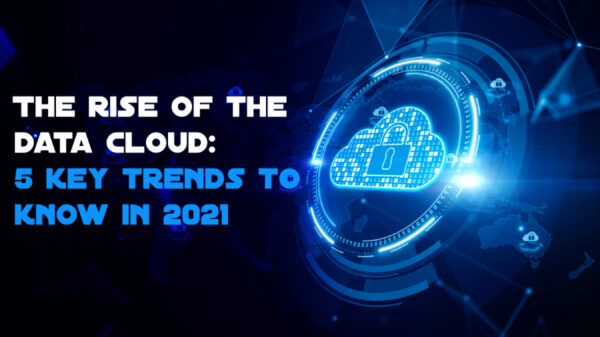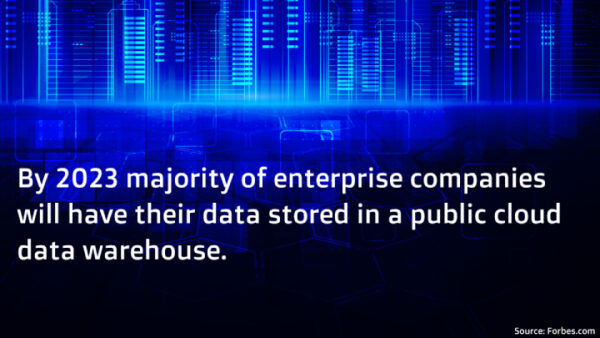
The Vs of Big Data were recently upgraded to 7 from 5, with Variability and Visualization joining the original five – Volume, Velocity, Variety, Veracity, and Value. This increase is a tacit acknowledgment that data is not just getting more expansive but also more complicated, if not convoluted.
The five key trends of data for 2021 will be AI, cloud containers, data democracy, as well as edge and serverless computing. Nothing exists in a vacuum and all of these trends were heavily affected by the 2020 pandemic, and, in many ways, these technologies all move in concert together, AI utilizes containers, which work well on serverless, which help democratize data.
Once the pandemic hit and companies all over the world were forced to provide work-from-home capabilities, these trends proved instrumental in keeping business as usual going – as far as business-as-usual could continue in a raging pandemic. All of these trends will continue to flourish in the coming years. They are not flash-in-the-pan momentary successes. They are sophisticated business-altering technologies that all executives should be aware of as well as continue to follow.
AI
In 2021, the cloud will help AI further realize its abundant potential, perhaps not reach the heady heights of hype so many have promised but the massive amounts of data flowing into and through the cloud will definitely help turn promise into reality. AI is a difficult technology to implement, but the cloud and software like containers, Kubernetes, serverless computing, and powerful ML frameworks will help users create more responsible and scalable AI.
Over the past few decades, many key cloud-enabled breakthroughs helped raise AI from a technology that was floundering to one of almost limitless potential. These include the emergence of affordable parallel processing, Big Data, and its 7 Vs, as well as the access to improved ML algorithms from companies like Google, Microsoft, and Facebook. Because of their “build once, deploy anytime, anywhere capabilities”, cloud containers help facilitate the development and deployment of AI apps, which, in turn, democratizes AI.
Containers
Containers are an executable unit of software that consists of packaged application code along with all necessary software libraries and dependencies that run it. Containers are self-contained units that include everything needed for them to run and they can run anywhere, whether that is on the desktop, within traditional IT, or in the cloud.
Gartner believes containers are the preferred way to package machine learning models, which can be utilized from other external applications without any coding requirements. Containers can include the entire machine learning pipeline. They can scale as needed and be spun up in minutes. During ML training phases, containers can utilize multiple host servers, and then the trained models can be spread across multiple container endpoints and deployed wherever needed.
Although similar to a virtual machine (VM), containers don’t virtualize the underlying hardware, just the operating system, as well as the needed libraries and dependencies. This helps keep containers lightweight, fast, and highly portable. Containers also support modern development and architecture like DevOps, serverless computing, and microservices.
Data Democratization
For businesses today, data has almost become ubiquitous. ‘Visualization’ is one of the additions to 7 vs of Big Data but its late addition shouldn’t be construed as a lack of importance. Quite the opposite. It is perhaps one of the most important of the 7 Vs. Inexpensive BI tools like Tableau, Qlik, and PowerBI are gaining traction at businesses both big and small, and visualizing data is one of the best ways to extract value from it.
2021 will see more IT departments relinquishing power over their IT tools and software, democratizing more data. It won’t just be the business intelligence tools, data integration tools like Alteryx, Knime, RapidMiner, SAS, and Databricks. The business of the self-service analytics tools will continue to grow. The growing citizen data scientist movement will continue unabated. The democratization of data will allow employees at all levels of a business to explore and analyze data on their desktops, their hand-held mobile devices, almost anywhere.
Edge Computing
Most data comes with an expiration date and this is the theory behind edge computing. Why capture data on an edge device, send itin to the cloud, build the models on software up there, compile the results, then send those back to the edge device which initially captured the data, which then use that to send out an alert, or an offer should the edge device be part of a marketing system? Why not just have the edge device also build the models? With hardware getting smaller and software much more sophisticated, highly complex models can be included on an edge device, at the edge of the cloud, making the data much more useful and action-oriented.
Large vendors, like AWS, Dell, HPE, Google, IBM, and Microsoft, are embracing an edge cloud strategy that takes advantage of serverless computing models. Data can flow data through real-time applications at the cloud edge, straight into a consumer’s mobile device. IoT solutions can now be deployed just about anywhere, and cloud providers are adding edge compute services to help with content delivery across hundreds of thousands of local points of presence.
2021 will also see a greater emphasis on enterprise network edge security and protecting users, services, applications, and data, as enterprises embrace distributed application environments.
Serverless Computing
Serverless computing lets developers what developers do best – write code. Setting up and maintaining the infrastructure and servers running that code, along with the maintenance needed to ensure the systems are running properly is handled by the cloud providers. In 2018, Gartner singled out serverless computing as one of its ten computing trends for infrastructure and operations and time has proven Gartner’s prediction right.
Serverless computing integrates the capabilities of Backend as a Service (BaaS) and the cloud provider handles all system infrastructure management, operation and maintenance costs, security, and software patches and upgrades, while also letting clients focus on just creating applications.
Conclusion
After a truly one-of-a-kind year in 2020, the world is ready to get back to business as usual, if that’s possible. Business as usual is going to be difficult to attain. ‘The trend is your friend’ is the quote that investors keep in mind as they put their hard-earned money on the line in the stock market. It’s an idea that IT executives should keep in mind as it works for technology too. AI, containers, data democratization, edge computing, and serverless computing should help all executives keep their business optimized and future-proof.
